Bengal cats are indeed wonderful, but we know the word wonderful can go both ways – wonderful creatures or wonderful disasters. This article will hopefully get you prepared enough for the Bengal cat’s personality so that most of the time, they are wonderful creatures and not wonderful disasters.
Bengal cats are beautiful cats and have become more and more popular over the years. However, not many people are prepared to handle a Bengal cat with all of their energy and quirks, and sometimes they end up being abandoned or given away (happens more than you might think).
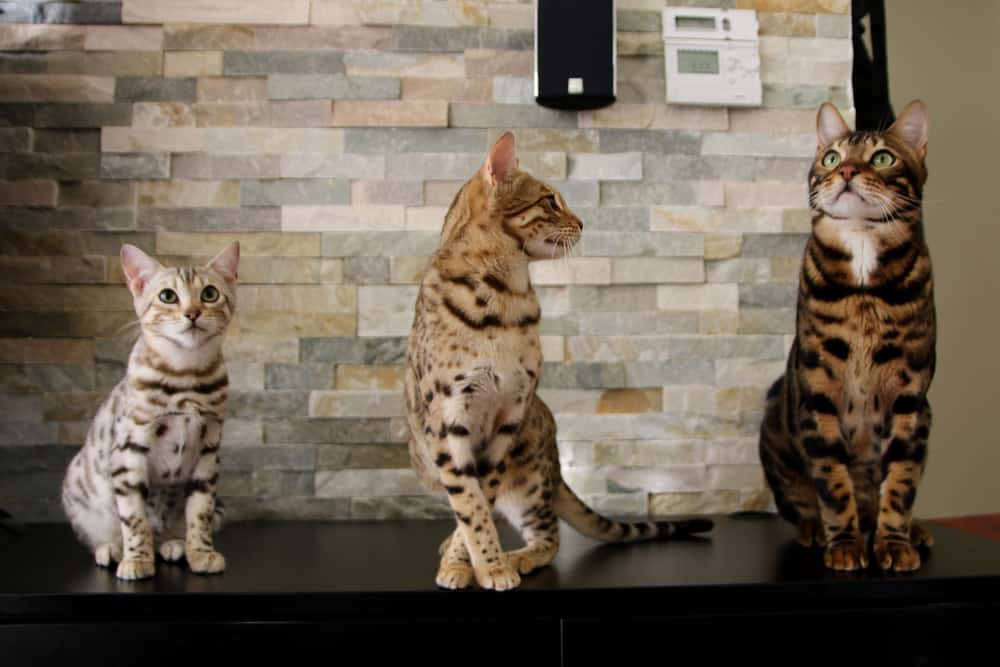
For me, I have lived with my Bengal cat, Latte, for many years inside a tiny space ever since he was a kitten. Honestly, it was challenging at first, but as I kept learning and improving the way I interact with him every day – the issues that I had with him eventually subsided.
So before deciding to take in a Bengal cat, make sure you’ve understood what makes them tick and how to satisfy each one of those points for the best situation for you and your new special feline friend!
Bengal Cat Personality
Bengal cats are…in a couple of words – like a human toddler. An adorable cat toddler that wants to be around and with you. Not only be around though but also try to participate and be as physical as possible with whatever it is that you’re doing. Also, as with any baby or toddler, we have to create an environment for them that’s safe and stimulating. Read my article to see all the ways to do this: How to Bengal-Proof Your Home.
Essentially they are like any household cat but on steroids. They are intensely curious about everything, and they’re confident enough to prod at anything to invoke a reaction. Thus, they require quite a bit more maintenance than many other cat breeds.
One strange example is the stove, just a regular stovetop that exists in any home or apartment. My Bengal cat loves to wait until I’m finished cooking and hit the stovetop because he saw some flames there. Be careful about having an open flame around a Bengal cat. They are too drawn to it.
Below are some other actions that a typical Bengal cat might exhibit compared to a normal domestic housecat.
| Normal Cat Actions | Bengal Cat Actions |
| Knock something off the table | Knock something off the table and then take it apart or carry it off somewhere to then…be taken apart. |
| Wait for an opportune moment to go inside a room | Try every method under the sun to get to where they want to be (usually that’s to you in the other room). If you don’t think they’ll jump, they’re going to jump. If you don’t think they can open a door, well, they’re going to surprise you and open the door. |
| Drink from a water bowl | Swipe at the bowl to make sure it’s clean, and then drink from it. |
| Play with a ball | Play fetch and bring the ball to your lap (basically telling you he wants to play) |
| Find treats on the floor | Open up drawers and cabinets and go on a deep dive mission to retrieve snacks for all of his friends. |
| Meow | When they’re bored, they’re going to yowl and meow like someone is trying to kill them. |
| Look at running water | Splash and try to catch the water that’s coming out from the tap or faucet |
| Get fat from boredom | Bengal Cats rarely stay in one spot, but they are more likely to develop quite destructive habits if their environment or lifestyle is not adequate. |
Even looking at them directly into their eyes is enough to get them going. They get super curious and will directly walk towards you and engage with you.
Also read: How Much Do Bengal Cats Cost? 2022 Complete Guide!
What’s It Like to Live With Bengal Cats Day to Day?
For most people, what they’re reading thus far might sound fun because that sounds super unusual for a cat, but in reality – it can be a bit overwhelming and extremely distracting. A lot of willpower and patience will be required at times.
Sometimes if I’m busy doing something for work on the computer and my Bengal cat is chatty or meows, I try my best to ignore it. Because if you respond to them – well, you better be prepared for the next 20 minutes to give them all your attention.
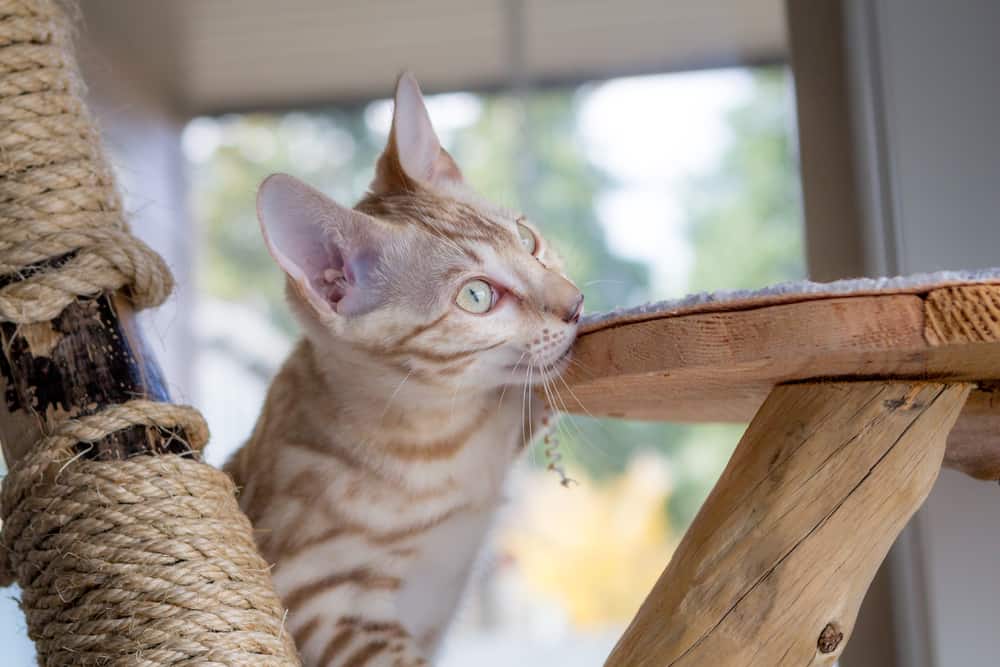
Here’s how a typical day would go with a Bengal cat. This is how my Bengal cat behaves after being trained and learning my schedule after some consistent efforts.
Morning: they’ll be there to greet you in the morning, or if you’re in another room, they’ll be yelling at you to wake up to feed them. There would also be some attempts to open the food container (remember to keep food and storage containers secure).
Luckily, they’re generally pretty quiet in the morning, but they’ll be quite clingy. Shadowing your every step and maybe rolling around beside you (note: be careful of where you step – Bengal cats are lightning quick).
Noon – Afternoon: they’ll start thinking about stuff to do, either bothering friends (other cats around the home) or playing with whatever is near. My Bengal cat loves to walk/run on the exercise wheel. When I didn’t have the wheel, he would be zooming up and down the cat pole.
It’s recommended to have many distractions to keep them out of trouble when you’re at work.
Evening – Night: when you get home from work, don’t be surprised that you see some stuff being dragged out of cabinets or bags all over the floor (did I tell you to secure your drawers and cabinets yet? Secure your drawers and cabinets).
This is when their energy level starts ramping up. And they’ll be jumping around and yelling for something to do. They’ll either find a ball and tell you to play with them (by putting the ball on your lap), or they’ll start yowling and yelling until something interesting happens.
After the play session (for more information on how to play with any cat properly, read about it in my article: How to Properly Play With Your Cats), they are finally able to calm down a little bit and then be ready for bed.
Are Bengal Cats Affectionate?
Many people wonder if Bengal cats are affectionate despite their massive amounts of energy, and they absolutely are. They are incredibly affectionate, but affection might differ from Bengal to Bengal depending on how well they were socialized.
All cats have in common is how they were handled or trained when they were in their peak socialization period, which is how they’ll be the rest of their lives. If they had a great socialization period that is totally accustomed to humans, then they’ll likely be friendly, social, and affectionate to humans when they’re adults.
From my experience and what I’ve seen and observed from my Bengal cat and other people’s Bengal cats, they are quite clingy and physical with their affection.
They don’t like to be forced to cuddle, but when they’re in a cuddly mood, they can be quite clingy. They’ll curl up on your lap or beside you for a period of time.
These cuddle times are quite valuable because Bengal cats are usually zooming around here and there, so when they do take time to stop and want to be around their special humans, it’s a wonderful feeling.
My Bengal cat, Latte, when he wants to have some attention while I’m on my computer, literally stands up and taps me on the arm. The first time he did it, I laughed so hard because it’s almost like a human toddler asking their parents for some attention. One day I would love to capture this on video.
He also loves to groom me when he’s in his cuddly/affectionate mood. He’ll curl up on my lap or in my arms while I’m lying down and start to groom what little arms hairs that I have. It’s super adorable to watch.
Are Bengal Cats Playful? How Energetic Are They?
They are the most playful cats out of any cat breed out there. Bengal cats are always ready for an interactive session of chase or fetch (make the most out of fetch!).
Bengal cats respond most to interactive toys such as wand toys or bouncy balls (especially rubber bouncy balls). They are true hunters and are incredibly confident when they hunt and play. This is why interactive toys are the best tools for curbing their energy levels.
They can play for longer than many other cats, while most cats will probably be down for the count and tired out by a 20-minute session. A Bengal cat might require 30 to 40 minutes of a nice meaty play session.
-
 Check Price!
Check Price!This wand features an 18-inch plastic wand and a 6-inch flex cable for extra bounce, along with crunchy plastic strips that are stronger and more durable than the mylar typically used in similar toys. The soft, natural feathers add even more enticing fun to this high-quality toy that is proudly made in the USA.
We earn a commission if you click this link and make a purchase at no additional cost to you.
-
 Check Price!
Check Price!This prey-set brings great variety to fit all cat's hunting preferences. This allows you to try a lot of different types of prey for your interactive wand and has great reviews.
We earn a commission if you click this link and make a purchase at no additional cost to you.
-
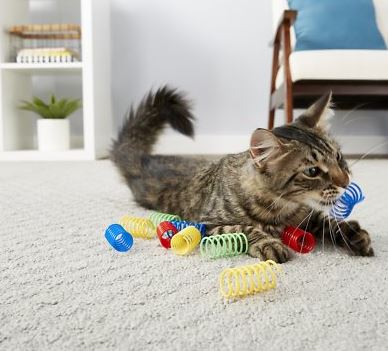 Check Price (US) Check Price (CA)
Check Price (US) Check Price (CA)Sometimes the most effective toys are the simplest. I use these springs almost every day for my cats (my Bengal cat loves this!) and it's a great toy for fetch as well! Erratic bounce stimulates your kitty’s hunting instincts to get them playing. Vibrant colors are designed to grab your cat’s attention for even more exciting play. Helps provide the daily exercise and mental stimulation cats need.
We earn a commission if you click this link and make a purchase at no additional cost to you.
-
 Check Price (US) Check Price (CA)
Check Price (US) Check Price (CA)They're foam balls that bounce everywhere. Cats love to chase them down and some really active cats (Bengals especially) are able to learn to fetch. Also a great tool for bite misdirection!
We earn a commission if you click this link and make a purchase at no additional cost to you.
Now the trouble comes when you’re busy, and your Bengal hasn’t quite learned what is expected of them – they’re going to find something else to do.
This can range from playing with other cats or finding a new toy to play with (i.e., stuff around the home). This is something you want to avoid because it can create habits that you might not necessarily want.
This can be a little stressful for owners who don’t know exactly why their Bengal cat is doing what they’re doing. The owners might think that they are destructive, but in reality, it’s just them trying to find an outlet for all the energy that they might have.
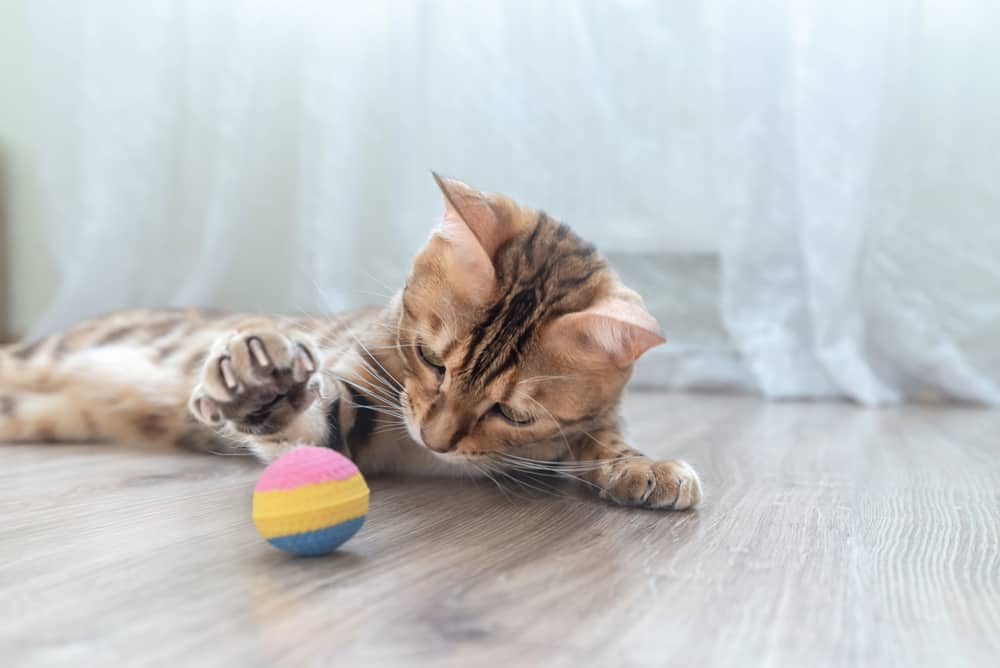
A Bengal kitten is something that is both adorable and like the Tasmanian devil. They have seemingly endless energy. This is the time period when you really have to give them the attention and play the need to prevent any bad behavior traits.
I was without sleep for a couple of days before I knew how to curb Latte’s energy levels. Usually, the way to prevent many issues that people are having with their Bengal cat comes down to their energy levels.
A tired Bengal cat is a good Bengal cat. There are many methods of how to tire out your cats, and some take more effort than others, but I go through the best methods on how to tire out your Bengal cat (click here!).
Are Bengal Cats More Aggressive Than Other Cats?
Bengals are not a more aggressive cat breed. Aggressive would mean that they would have some negative intention in their actions. Any cat can be aggressive if they’re not comfortable in their surroundings or an intruder is in their territory.
An aggressive cat will have flattened ears, be very vocal, and be incredibly sensitive to everything around them. They will likely be hiding in the corner.
However, that’s not the case about 99% of the time. A Bengal is just an impatient cat. Sometimes their impatience gets them into trouble (hmm…sounds a lot like young humans).
For how Bengal acts, react and behave, it’s better to say they are bold and confident Breed. They are not afraid to try something or interact with something physical. This might be viewed as aggressive by some people because their boldness gets misunderstood as aggression.

To give a situation as an example, many cat owners have those puzzles treat toys that you put treats in, and the cat has to figure out how to get to the treat. Normal cats would observe it for a bit, then maybe sniff it to make sure it’s safe, and then finally maybe paw at it to get the treats out.
Bengal cats have an entirely different decision-making process, they will skip the observe and sniffing part and whack at it until something pops out. If it’s something pleasant like a snack, great, they’ll keep doing it. If it’s something unpleasant, then they’ll probably not do it again.
They seem to act first, and then depending on how the object reacts – they will decide whether or not to continue the action.
This, as a result, creates an entertaining and interesting cat to be around but can be interpreted as aggression if one is unfamiliar with the signs of aggression.
What Should You Do When Your Bengal Cat is Exhibiting Negative/Destructive Behaviors?
Because Bengal cats tend to be more bold and confident in their actions, they will learn to keep doing it whenever they get any reaction. As such, they tend to invoke a lot of anger and frustration from their owners, however. However, they can’t control themselves.
This causes many people to search for a way to discipline their Bengal cats, but there are other ways of guiding our cats to doing the proper things that don’t involve any squirt guns or yelling or any physical contact with our beloved pets.
The way to guide behaviors is by using yes/no environments. Environments/objects that are made for them to go onto or use and environments or objects make them uncomfortable/hard to get to. Thus, they recognize that it’s something not to be interacted with.
For example, if your cat scratches the wrong things – create an uncomfortable surface to scratch on by using double-sided sticky tape on the surface (no, surface) and then have a high-quality, tall and stable cat tower beside it (yes, surface).
-
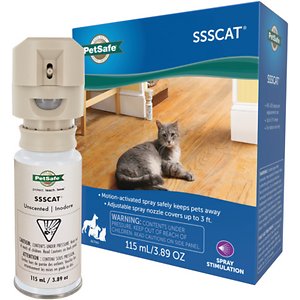 Check Price!
Check Price!The PetSafe SSSCAT Deterrent Cat Spray easily protects indoor areas and objects from your pets. This unique spray uses motion-activated infrared to monitor movement up to 3 feet away. When the SSSCAT detects your pet entering an off-limit area, it emits a harmless, odorless, and stainless spray to deter your pet from continuing.
We earn a commission if you click this link and make a purchase at no additional cost to you.
-
 Check Price!
Check Price!When push comes to shove, this can be a good tool to our teach cats what areas are unacceptable to be on. This is for people that don't want certain furniture to be scratched up and for stubborn cats that are set in their ways scratching up a certain type of furniture or material.
We earn a commission if you click this link and make a purchase at no additional cost to you.
-
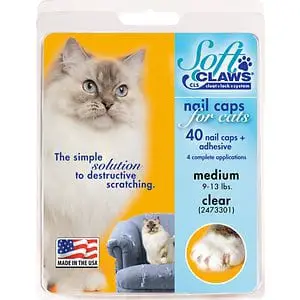 Check Price!
Check Price!Save your floors and furniture with Soft Claws Cat Nail Caps. A safe and pain-free alternative to declawing, Soft Claws works by simply capping your cat’s claws with a vinyl cover. It applies easily with a safe and non-toxic adhesive, and will not interfere with the normal extension and retraction of their nails—which means even the fussiest kitty won’t mind wearing them. So your cat can go about his routine of pawing and playing, and you don’t have to worry about unwanted scratches. Easy to apply and long-lasting, it’s made right here in the USA.
We earn a commission if you click this link and make a purchase at no additional cost to you.
-
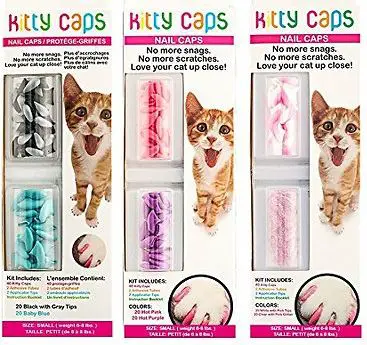 Check Price!
Check Price!Nail caps provide a safe alternative to declawing to stop all snags and scratches. Covers the nail completely while allowing normal extension and retraction of claws. Applied with included adhesive and will shed as your cat’s nails grow; generally in 4 - 8 weeks. Easy to apply and vinyl resin material is totally safe for cats. Choose from a variety of fun colors!
We earn a commission if you click this link and make a purchase at no additional cost to you.
-
 $12.99Check Price!
$12.99Check Price!These sticks have a similar effect to catnip for cats. Have these sticks around for your cats to bite and chew so that they don't chew other stuff around in your apartment or home (cables, electronic components, etc.). It also acts as a great teeth cleaner too!
We earn a commission if you click this link and make a purchase at no additional cost to you.
09/02/2025 06:17 pm GMT -
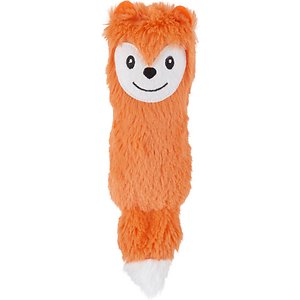 Check Price (US) Check Price (CA)
Check Price (US) Check Price (CA)This is another great tool for misdirection for when your cat is overstimulated and prone to biting. The furry tail adds motion to stimulate your kitty’s hunting instincts, so toss it to give him the thrill of the chase. It’s also spiked with Canadian catnip for even more exciting play
We earn a commission if you click this link and make a purchase at no additional cost to you.
It begins to allow them to associate certain things that are better to scratch, and certain things are not that great to scratch.
Another example would be biting – not humans but other objects around the room. My Bengal cat uses to have a habit of biting plastic antennas and similar objects – basically, anything plastic that stuck out. Not only is this damaging our valuables, but it poses a health risk for our cats (choking hazards, chemical substances, etc.).
I corrected this behavior to have things that he could bite (matatabi sticks, wooden sticks that have similar effects with catnip) and tried my best to keep the plastic stuff in harder-to-reach areas.
Now, he is much less likely to bite these plastic objects and would rather bite his matatabi sticks than anything plastic.
I go into this concept a lot more in-depth in this article: How to Discipline a Bengal Cat.
Can Bengal Cats Get Along With Other Cats?
Bengal cats are like any other cat, they love company and attention, and it doesn’t have to be from their owners. Frankly, they should have a companion because it gives their owners a break.
Bengal cats, in general love, to play rough. As said before, they’re quite bold and love to play games wrestling and pounce on other cats. As such, owners should pair them with cats that like to wrestle and play a little roughly.
Usually, this means pairing your Bengal cat with male cats rather than female cats. Male cats are more likely to engage in rough play (for more information about how male and female cats differ, read about it here in my article: Male or Female Cat?)
Bengal cats can keep other cats busy, though, and it might be stressful for more timid cats since they’re so active – they always want to play or do something together.
At night time is the best, though, as they’ll likely find a friend to warm up beside as they sleep.
How to Keep Bengal Cats Happy?
I’ve been living with my Bengal cat in a studio apartment for a long time. I’ve raised him here from a kitten to an adult cat. He is a well-adapted and socialized cat that’s free from negative behavioral traits.
If it can do it in this small space, you can do it too!
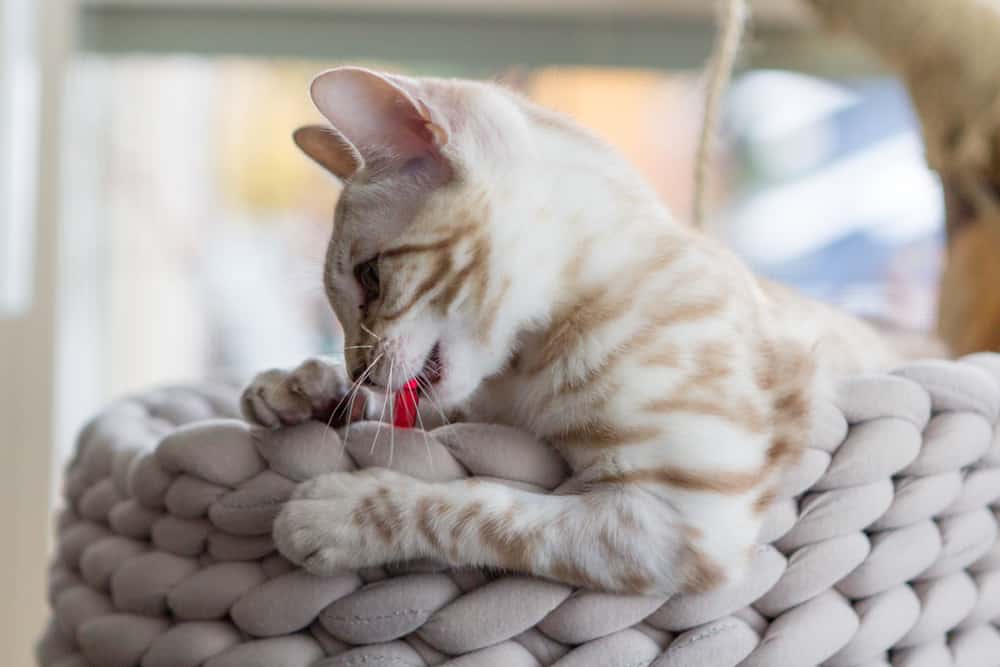
The key to having a Bengal cat is to know when they are bored and to give them the right amount of attention and stimulation. Other than that, they are wonderful cats that love to be around their humans.
- Get them a companion – cats learn a lot from each other, especially if they have a friend to learn from at a young age. So if it’s possible to have another friend with your Bengal cat, It is recommended.
- For smaller places such as apartments – maybe think about getting a cat exercise wheel. Bengal cats learn quickly and take to them almost immediately. You’ll find them jogging and running on them almost every day (For more on cat wheels: Are Cat Wheels Worth It?)
- Have play environments that can vary the style of play – cats love to burrow and go into small places, which is why they love boxes. There are a lot of play environment products out there to provide them this style of play. For recommendations about play environments and other toys: read Best Toys for Indoor Cats!
- Set a play schedule (What’s the most optimal playtime for cats?) – I’ve said this so many times in my other articles about Bengal cats but it helps them so much. A play schedule and routine let your cats adapt to your lifestyle and schedule.
- Provide them with places to run/burrow/hide/climb (catification) – this not only naturally lets them release their energy but also allows them to start associating these areas as theirs and not human furniture.

I recently adopted a Bengal mix. He or she (not sure yet) that is approx 8-10 weeks old. As u said, he is quite active and toes and fingers r his favorite prey. I have been guilty of playing rough w it and then wanting to stop. I’ve found usually I can rub and gently scratch his back while getting him off my other hand works but do u have any ideas on discipline to teach him not to bite or claw when playtime is over? I know it’s normal stalking and hunting behavior so I don’t want to deter that ability since we live n the country and occasionally have a rat problem.